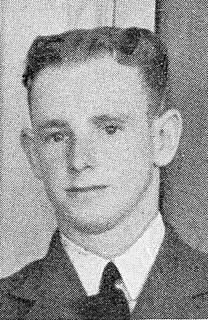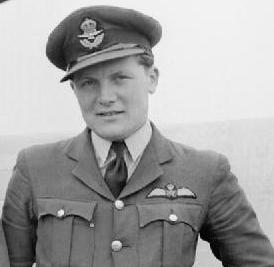
Air Vice Marshal William Vernon Crawford-Compton, was a New Zealand flying ace of the Royal Air Force (RAF) during the Second World War. He was officially credited with destroying at least 20 enemy aircraft.

James Joseph "Orange" O'Meara, was a Royal Air Force officer and fighter pilot of the Second World War. He became a flying ace during the Battle of Britain while flying the Supermarine Spitfire, and by war's end was credited with 11 kills, two shared victories, one unconfirmed destroyed, four probables, 11 damaged and one shared damaged.
George Herman Bennions, DFC, nicknamed "Ben", was one of the leading Battle of Britain Spitfire pilots.

Air Commodore Alan Christopher Deere, was a New Zealand fighter ace with the Royal Air Force (RAF) during the Second World War. He was also known for several near-death experiences over the course of the war. This led to his published autobiography being titled Nine Lives.

Group Captain Colin Falkland Gray, was a Royal Air Force (RAF) officer and the top New Zealand fighter ace of the Second World War.

Raymond Brown Hesselyn, was a New Zealand fighter pilot and flying ace of the Second World War, credited with the destruction of at least 18 enemy aircraft while flying with the Royal Air Force over Europe and the Mediterranean.

Eric Stanley Lock, was a British Royal Air Force (RAF) fighter pilot and flying ace of the Second World War.
Brian Carbury, was a New Zealand fighter ace of the Royal Air Force (RAF) during the Second World War. He was officially credited with destroying 15+1⁄2 enemy aircraft.

John Colin Mungo-Park, was a Royal Air Force fighter pilot and flying ace of the Second World War. He was awarded the Distinguished Flying Cross in 1940, and a Bar to the medal in 1941.
Squadron Leader Hilary Richard Lionel "Robin" Hood, was a Royal Air Force fighter pilot of the Second World War, who was killed during the Battle of Britain.

John Charles Dundas, was a Royal Air Force fighter pilot and flying ace of the Second World War credited with 12 victories.
Group Captain George Lovell "Uncle" Denholm, was a Scottish fighter pilot and flying ace of the Royal Air Force during the Second World War. He flew Spitfires during the Battle of Britain, and is counted amongst the ranks of 'The Few'.
William Henry Franklin, DFM and Bar also known as Bill Franklin was a Royal Air Force fighter pilot and a notable Second World War flying ace decorated for gallantry twice, he shot down more than 13 enemy aircraft over the Dunkirk evacuation beaches and during the Battle of Britain before being killed in action.

John Noble MacKenzie, was a New Zealand flying ace of the Royal Air Force (RAF) during the Second World War. He was officially credited with the destruction of nine enemy aircraft.

Group Captain Edward Preston Wells was a New Zealand flying ace of the Royal New Zealand Air Force (RNZAF) during the Second World War. He was credited with the destruction of twelve enemy aircraft.

Newell Orton, was a British flying ace of the Royal Air Force (RAF) during the Second World War. He was officially credited with the destruction of 17 enemy aircraft.
William Thomas Edward Rolls was a British flying ace of the Royal Air Force Volunteer Reserve (RAFVR) during the Second World War. He was credited with the destruction of at least 17 aircraft of the Axis powers.
Bryan Vincent Draper was a British flying ace of the Royal Air Force Volunteer Reserve (RAFVR) during the Second World War. He was credited with at least six aerial victories.

Wing Commander Richard Macklow Trousdale was a New Zealand flying ace of the Royal Air Force (RAF) during the Second World War. He was credited with at least six, possibly seven, aerial victories.

Harbourne Mackay Stephen was a British flying ace of the Royal Air Force Volunteer Reserve (RAFVR) during the Second World War. He was credited with the sole destruction of at least nine aircraft of the Axis powers.













